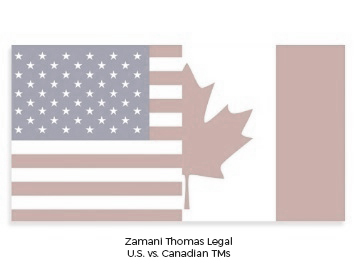U.S. vs. Canadian Trademarks | 6 Differences
Canadians should consider trademarking their brands in the U.S. due to its much larger consumer market, for protection against cross border infringement and to secure their brand’s identity in cross-border trade (particularly now with e-commerce etc.). Without a U.S. trademark, many Canadian brands risk losing their competitive advantage in the United States.

Below are 6 clear differences between U.S. vs. Canadian Trademarks and their processes:
- The Use Requirements for Registration & Filing Basis
- U.S.: An applied for trademark in the United States has a requirement that it is currently being used in commerce for it to be registered with the USPTO. Applicants are able to file for a trademark with an “Intent to Use” 1(b) filing basis, however, the examiner will not register the mark until there is evidence of that mark in use with a 1(a) filing basis.
- Canada: Trademarks in Canada are not required to be “In Use” in order for the registration to occur, thus no filing basis is required. However, in order to maintain your trademark long term, the mark must be In Use or the trademark could be removed from the Register of Trademarks
- Trademark Duration and Renewal of U.S. vs. Canadian Trademarks
- U.S.: Registered marks in the United States must be renewed every 10 years and a declaration of continued use must be filed between the 5th and 6th year to maintain the registration.
- Canada: Registered marks in Canada must be renewed every 10 years, however do not require any midterm declarations
- Distinctiveness of U.S. vs. Canadian Trademarks
- U.S.: The USPTO maintains that distinctiveness is a critical element of a registered mark. If your mark is generic or descriptive it is not registerable. If your mark is descriptive the USPTO may ask for proof of “Secondary meaning”
- Canada: Distinctiveness is important in Canada but is not as narrowly monitored as in the States. The Canadian Intellectual Property Office (CIPO) may accept broader descriptive elements than its U.S. counterpart.
- Trademark Opposition
- U.S.: Oppositions in the U.S. are filed with the Trademark Trial and Appeal Board (TTAB) which operates as a semi-judicial body.
- Canada: Oppositions in Canada are handled by the CIPO itself and not as formal as the TTAB procedure.
- Examination of Applicants and Scope of Protection
- U.S.: The USPTO has a stricter and more in depth examination process; Particularly their assessment of “likelihood of confusion” analysis with existing registered (and times applied for) marks.
- Canada: The CIPO process is not as rigorous overall, but does include a broader assessment of descriptiveness and registerabilty.
- Nationwide Protection
- U.S.: Federal and State registrations are available in the U.S.. However federal registrations are considered superior and only available if the mark is being used in interstate commerce.
- Canada: Registered trademarks in Canada enjoy federal protection even in cases where there is no inter-provincial or international trade.
Navigating the trademark landscape requires more than just filing paperwork, it’s about understanding the legal frameworks that govern your brand across borders. The differences between U.S. vs. Canadian trademarks may seem procedural on the surface, but they have real consequences for your business strategy. Whether you’re a Canadian entrepreneur entering the U.S. market or a U.S.-based creative seeking protection in Canada, knowing how each country handles use requirements, opposition, distinctiveness, and renewal timelines can save you time, and money.
As online business continues to blur national boundaries, dual protection has become more than a best practice, it’s a competitive necessity. If you’re serious about your brand, investing in proper guidance around U.S. vs. Canadian trademarks ensures your creative work is protected wherever your audience finds you.
